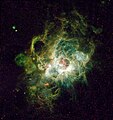Lahabali kɔligu:Nursery of New Stars - GPN-2000-000972.jpg
Yi palo

Jɔhiyuli maa galisim:563 × 600 anfooni bihi bihi. Din pahi resolutions: 225 × 240 anfooni bihi bihi | 450 × 480 anfooni bihi bihi | 721 × 768 anfooni bihi bihi | 1,127 × 1,201 anfooni bihi bihi.
Faal maa maŋmaŋa (1,127 × 1,201 pixels, file size: 2.42 MB, MIME type: image/jpeg)
Faal tarihi
Dihimi dabisili/saha n-nya kɔl' bihi kamani di ni di yina shɛm
| Zuŋɔ dabisili/Saha | Thumbnail | Di tarisi | ŋun su | tɔhibu | |
|---|---|---|---|---|---|
| din na chana | 18:12, 8 Silimin gɔli August 2019 |  | 1,127 × 1,201 (2.42 MB) | BevinKacon | Reverted to version as of 01:11, 9 April 2009 (UTC) bad upscale by new user |
| 13:38, 3 Silimin gɔli August 2019 |  | 1,690 × 1,800 (2.84 MB) | Armin3636 | بالا بردن کیفیت | |
| 12:08, 29 Silimin gɔli July 2019 |  | 1,024 × 1,091 (1.21 MB) | Armin3636 | بارگذاری کامل پرونده | |
| 01:11, 9 Silimin gɔli April 2009 |  | 1,127 × 1,201 (2.42 MB) | BotMultichillT | {{Information |Description={{en|1=This is a Hubble Space Telescope image (right) of a vast nebula called NGC 604, which lies in the neighboring spiral galaxy M33, located 2.7 million light-years away in the constellation Triangulum. This is a site where |
Lahibali kɔligu zaŋ tum tuma
Yaɣi shɛli kani din mali lahabali kɔligu ŋɔ n-kuri bukaata.
Duniya zaa lahabali kɔligu zaŋ tum tuma
Wikis shɛŋa ŋan dolina ŋɔ gba malila faal ŋɔ n kuri bukaata:
- Zaŋ tum tuma af.wikipedia.org zuɣuc
- Zaŋ tum tuma anp.wikipedia.org zuɣuc
- Zaŋ tum tuma an.wikipedia.org zuɣuc
- Zaŋ tum tuma ar.wikipedia.org zuɣuc
- Zaŋ tum tuma arz.wikipedia.org zuɣuc
- Zaŋ tum tuma ast.wikipedia.org zuɣuc
- Zaŋ tum tuma az.wikipedia.org zuɣuc
- Zaŋ tum tuma ba.wikipedia.org zuɣuc
- Zaŋ tum tuma be.wikipedia.org zuɣuc
- Zaŋ tum tuma bg.wikipedia.org zuɣuc
- Zaŋ tum tuma bn.wikipedia.org zuɣuc
- Zaŋ tum tuma bs.wikipedia.org zuɣuc
- Zaŋ tum tuma ca.wikipedia.org zuɣuc
- Zaŋ tum tuma ceb.wikipedia.org zuɣuc
- Zaŋ tum tuma ce.wikipedia.org zuɣuc
- Zaŋ tum tuma cs.wikipedia.org zuɣuc
- Zaŋ tum tuma da.wikipedia.org zuɣuc
- Zaŋ tum tuma de.wikipedia.org zuɣuc
- Zaŋ tum tuma de.wikibooks.org zuɣuc
- Zaŋ tum tuma diq.wikipedia.org zuɣuc
- Zaŋ tum tuma el.wikipedia.org zuɣuc
Yulima more global usage zaŋ chaŋ lahabali kɔligu ŋɔ.
